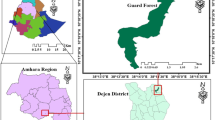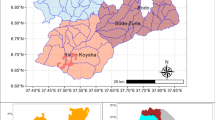Abstract
The mangrove vegetation of a disturbed and undisturbed site in bothKenya and Sri Lanka was investigated in the field for three vegetation layers:adult trees, young trees, and juvenile trees. A minimum of 25 sample points, inwhich the vegetation was described and environmental factors (salinity, lightintensity, land/water ratio, abundance of herbivorous crabs and snailabundance)were measured or estimated, were taken on each site. Detrended correspondenceanalysis (DCA) and canonical correspondence analysis (CCA) were used tosummarize the data bulk, to investigate the vegetation dynamics(e.g., comparability of species distribution in the threevegetation layers), and/or to link the vegetation data to the environmentalfactors. Results showed that species clusters were relatively easy todelineate,whether mangrove zonation was present or not. Among the environmental factors,the abundance of propagule predators (mostly sesarmid crabs) contributedsignificantly to the variation in vegetation and could be an explanatoryparameter for the observed vegetation data in a majority of sites. In the sitewhere it was not, the most important factor in the ordination was theland/waterratio, which is important at the ecological level as well (link between waterlevel and vegetation dynamics). However, none of the environmental factorscouldsuccessfully explain the total variability in the vegetation data suggestingthat other, more determining factors exist. Our results further provideinformation on the dynamic or non-dynamic nature of a forest and on its abilityto rejuvenate, and may contribute to appropriate forestry management guidelinesin the future.
Similar content being viewed by others
References
Aschbacher J., Ofren R., Delsol J.P., Suselo T.B., Vibulsresth S. and Charrupat T. 1995. An integrated comparative approach to mangrove vegetation mapping using advanced remote sensing and GIS technologies: preliminary results. Hydrobiologia 295: 285–294.
Ballerini T., Macia A. and Cannicci S. 2000. Zonation of Mangrove Crabs at Inhaca Island (Mozambique): a new hypothesis. Abstract Volume of the Meeting on Mangrove Macrobenthos, 7-11 September, Mombasa, Kenya.
Blasco F., Gauquelin T., Rasolofoharinoro M., Denis J., Aizpuru M. and Caldairou V. 1998. Recent advances in mangrove studies using remote sensing data. Marine and Freshwater Research 49: 287–296.
Brakel W.H. 1982. Tidal patterns on the East African coast and their implications for the littoral biota. In: Proceedings of the Symposium on the Coastal and Marine Environment of the Red Sea, Gulf of Aden and Tropical Western Indian Ocean 2., pp. 403–418.
Brokaw N. and Thompson J. 2000. The H for DBH. Forest Ecology and Management 129: 89–91.
Cannicci S., Skov M.W. and Vannini M. 2000. The influence of abiotic and biotic factors on the distribution of mangrove crabs at Mida Creek (Kenya): a multivariate approach. Abstract Volume of the Meeting on Mangrove Macrobenthos, 7-11 September, Mombasa, Kenya.
Cohen W.B., Kushla J.D., Ripple W.J. and Garman S.L. 1996. An introduction to digital methods in remote sensing of forested ecosystems: focus on the Pacific Northwest, USA. Environmental Management 20: 421–435.
Cottam G. and Curtis J.T. 1956. The use of distance measures in phytosociological sampling. Ecology 37: 451–460.
Curtis J.T. 1959. The Vegetation of Wisconsin. An Ordination of Plant Communities. University of Wisconsin Press, Madison, Wisconsin, USA.
Dahdouh-Guebas F. 2001. Propagule predation in Sri Lankan mangroves and its effect on vegetation structure dynamics. In: Mangrove vegetation structure dynamics and regeneration. F. Dahdouh-Guebas. PhD Dissertation, Vrije Universiteit Brussel, Brussels, Belgium.
Dahdouh-Guebas F., Coppejans E. and Van Speybroeck D. 1999. Remote sensing and zonation of seagrasses and algae along the Kenyan coast. Hydrobiologia 400: 63–73.
Dahdouh-Guebas F., Mathenge C., Kairo J.G. and Koedam N. 2000a. Utilization of mangrove wood products around Mida Creek (Kenya) amongst subsistence and commercial users. Economic Botany 54: 513–527.
Dahdouh-Guebas F., Thisera D.W.N., Wickramasinghe A. and Koedam N. 2001. Regeneration status of mangroves under natural and nursery conditions in Galle and Pambala, Sri Lanka. In: Mangrove vegetation structure dynamics and regeneration. F. Dahdouh-Guebas. PhD Dissertation, Vrije Universiteit Brussel, Brussels, Belgium.
Dahdouh-Guebas F., Verneirt M., Tack J.F. and Koedam N. 1997. Food preferences in Neosarmatium meinerti de Man (Decapoda: Sesarminae) and its possible effect on the regeneration of mangroves. Hydrobiologia 347: 83–89.
Dahdouh-Guebas F., Verheyden A., De Genst W., Hettiarachchi S. and Koedam N. 2000b. Four decade vegetation dynamics in Sri Lankan mangroves as detected from sequential aerial photography: a case study in Galle. Bulletin of Marine Science 67: 741–759.
Dahdouh-Guebas F., Verneirt M., Tack J.F., Van Speybroeck D. and Koedam N. 1998. Propagule predators in Kenyan mangroves and their possible effect on regeneration. Marine and Freshwater Research 49: 345–350.
Dahdouh-Guebas F., Zetterström T., Rönnbäck P., Troell M. and Koedam N. 2000c. Conservation of mangroves vs. development of shrimp farming in Pambala-Chilaw lagoon, Sri Lanka. In: Flos R. and Creswell L. (eds), Responsible Aquaculture in the New Millenium. European Aquaculture Society, Oostende, Belgium, p. 167.
Dahdouh-Guebas F., Zetterström T., Rönnbäck P., Troell M., Wickramasinghe A. and Koedam N. 2002. Recent changes in land-use in the Pambala-Chilaw Lagoon complex (Sri Lanka) investigated using remote sensing and GIS: conservation of mangroves vs. development of shrimp farming. Environment, Development and Sustainability (in press).
Dahdouh-Guebas F., Verneirt M., Cannicci S., Kairo J.G., Tack J.F. and Koedam N. An explorative study on grapsid crab zonation in mangrove forests in Kenya. Wetlands Ecology and Management (in press).
Duke N.C. 1991. A systematic revision of the mangrove genus Avicennia (Avicenniaceae) in Australasia. Australian Systematic Botany 4: 299–324.
Duke N.C. and Jackes B.R. 1987. A systematic revision of the mangrove genus Sonneratia (Sonneratiaceae) in Australasia. Blumea 32: 277–302.
Farnsworth E.J. and Ellison A.M. 1997. The global conservation status of mangroves. Ambio 26: 328–334.
Foell J., Harrison E. and Stirrat R.L. 1999. Participatory approaches to natural resource management - the case of coastal zone management in the Puttalam District. Summary findings of DFID-funded research ‘participatory mechanisms for sustainable development of coastal ecosystems’ (Project R6977), School of African and Asian studies. University of Sussex, Falmer, Brighton, UK.
Gallin E., Coppejans E. and Beeckman H. 1989. The mangrove vegetation of Gazi bay (Kenya). Bulletin de la Société Royal Botanique de Belgique 122: 197–207.
Gang P.O. and Agatsiva J.L. 1992. The current status of mangroves along the Kenyan coast: a case study of Mida Creek mangroves based on remote sensing. Hydrobiologia 247: 29–36.
Heil G.W. and Van Deursen W.P.A. 1996. Searching for patterns and processes: modelling of vegetation dynamics with geographical information systems and remote sensing. Acta Botanica Neerlandica 45: 543–556.
Hill M.O. and Gauch H.G. 1980. Detrended correspondence analysis: an improved ordination technique. Vegetatio 42: 47–58.
Hobbs R.J. and Grace J. 1981. A study of pattern and process in coastal vegetation using principal component analysis. Vegetatio 44: 137–153.
Holdridge L., Grenke W.C., Hatheway W.H., Liang T. and Tosi J.A. 1971. Forest Environment in Tropical Life Zones. Pergamon Press, NY, pp. 747.
Holmgren P. and Thuresson T. 1998. Satellite remote sensing for forestry planning - a review. Scandinavian Journal of Forest Research 13: 90–110.
Holmgren P., Thuresson T. and Holm S. 1997. Estimating forest characteristics in scanned aerial photographs with respect to requirements for economic forest management planning. Scandinavian Journal of Forest Research 12: 189–199.
Hyyppä J., Hyyppä H., Inkinen M., Engdahl M., Linko S. and Zhu Y.H. 2000. Accuracy comparison of various remote sensing data sources in the retrieval of forest stand attributes. Forest Ecology and Management 128: 109–120.
ITTO 1993. The economic and environmental value of mangrove forests and their present state of conservation. Prepared for the International Tropical Timber Organisation. Japan International Association for Mangroves and International Society for Mangrove Ecosystems, Okinawa, Japan.
IUCN 1996. Conservation management plan for ten selected mangrove sites in southwestern Sri Lanka. IUCN, Gland, Switzerland, November 1996.
Jayatissa L.P., Dahdouh-Guebas F. and Koedam N. 2002. A review of the floral composition and distribution of mangroves in Sri Lanka. Botanical Journal of the Linnean Society 138: 29–43.
Kairo J.G. 2001. Ecology and Restoration of Mangrove Systems in Kenya. PhD Dissertation, Vrije Universiteit Brussel, Belgium.
Kairo J.G., Gwada P.O., Dahdouh-Guebas F., Koedam N., Van Speybroeck D. and Ochieng C. Natural regeneration status of Mangrove Forests in Mida Creek. (in preparation) (unpublished).
Kent M. and Coker P. 1992. Vegetation Description and Analysis. A practical Approach. John Wiley & Sons, Chichester, UK.
Kjerfve B., de Lacerda L.D. and Diop E.H.S. 1997. Mangrove Ecosystem Studies in Latin America and Africa. UNESCO, Paris, France.
Lugo A.E. and Snedaker S.C. 1974. The ecology of mangroves. Annual Review of Ecology and Systematics 5: 39–64.
McCune B. and Mefford M.J. 1997. Multivariate Analysis of Ecological Data. Version 3.09. MjM Software, Gleneden Beach, Oregon, USA.
Mueller-Dombois D. 1968. Ecogeographic analysis of a climate map of Ceylon with particular reference to vegetation. The Ceylon Forester 8: 3–20.
Murali K.S., Siddappa Setty R., Ganeshaiah K.N. and Uma Shaanker R. 1998. Does forest type classification reflect spatial dynamics of vegetation? An analysis using GIS techniques. Current Science 75: 220–227.
Osborne D.J. and Berjak P. 1997. The making of mangroves: the remarkable pioneering role played by seeds of Avicennia marina. Endeavour 21: 143–147.
Pernetta J.C. 1993. Marine protected areas needs in the South Asian Seas Region. Sri Lanka. A Marine Conservation and Development Report. IUCN, Gland, Switzerland, vii + 67 pp.
Putz F.E. and Chan H.T. 1986. Tree growth, dynamics, and productivity in a mature mangrove forest in Malaysia. Forest Ecology and Management 17: 211–230.
Ramachandran S., Sundaramoorthy S., Krishnamoorthy R., Devasenapathy J. and Thanikachalam M. 1998. Application of remote sensing and GIS to coastal wetland ecology of Tamil Nadu and Andaman and Nicobar group of islands with special reference to mangroves. Current Science 75: 236–244.
Rehder J.B. and Patterson S.G. 1986. Mangrove mapping and monitoring. In: Damen M.C.J., Smit G.S. and Verstappen H.Th. (eds), Symposium on Remote Sensing for Resources Development and Environmental Management. ITC, Enschede, The Netherlands, pp. 495–497.
Smith T. and Huston M. 1989. A theory of the spatial and temporal dynamics of plant communities. Vegetatio 83: 49–69.
Spalding M., Blasco F. and Field C. 1997. World Mangrove Atlas. The International Society for Mangrove Ecosystems, Okinawa, Japan, 178 pp.
Tack J.F. and Polk P. 1999. The influence of tropical catchments upon the coastal zone: modelling the links between groundwater and mangrove losses in Kenya, India and Florida. In: Harper D. and Brown T. (eds), Sustainable management in tropical catchments. John Wiley & Sons Ltd, London, UK.
Tassan S. 1987. Evaluation of the potential of the Thematic Mapper for marine application. International Journal of Remote Sensing 8: 1455–1478.
Ter Braak C.J.F. 1986. Canonical correspondence analysis: a new eigenvector technique for multivariate direct gradient analysis. Ecology 67: 1167–1179.
Ter Braak C.J.F. 1994. Canonical community ordination. Part I: Basic theory and linear methods. Ecoscience 1: 127–140.
Tomlinson P.B. 1986. The Botany of Mangroves. Cambridge University Press, Cambridge, UK, 419 pp.
Ukpong I.E. 1995. An ordination study of mangrove swamp communities in West-Africa. Vegetatio 116: 147–159.
Verheyden A., Dahdouh-Guebas F., Thomaes K., De Genst W., Hettiarachchi S. and Koedam N. High resolution vegetation data for mangrove research as obtained from aerial photography. (submitted).
Author information
Authors and Affiliations
Rights and permissions
About this article
Cite this article
Dahdouh-Guebas, F., Kairo, J., Jayatissa, L. et al. An ordination study to view vegetation structure dynamics in disturbed and undisturbed mangrove forests in Kenya and Sri Lanka. Plant Ecology 161, 123–135 (2002). https://doi.org/10.1023/A:1020333706650
Issue Date:
DOI: https://doi.org/10.1023/A:1020333706650




